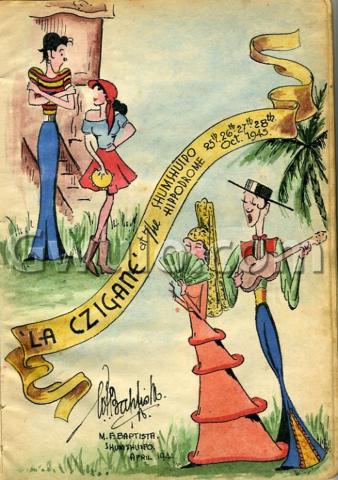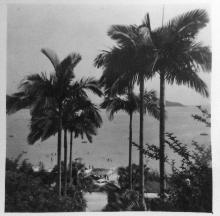Two very different events involving former internees are taking place today.
Close by in Stanley Prison two large trials of those accused of resistance activity in camp and in town are taking place. The centre of the morning trial - which has 27 prisoners, 15 of them Chinese- is the proceedings against John Fraser, who the Japanese - rightly - regard as the lynchpin of the Stanley resistance.
Fraser's suffering from dysentery, and as he cleans himself up in his cell block before the trial, he's beaten unmercifully by an Indian guard. His fellow prisoner, former camp Quartermaster W. J. Anderson, is a witness:
I will long remember the look of contempt on Fraser's face as he was forcibly pushed into his cell.
It's the start of a day in which Fraser is to show that prolonged torture and confinement have left his spirit completely unbroken - Anderson comments that he and the other prisoners all came to realise that Fraser was a 'great man'.
He's questioned at length and his activities, which include supervising and processing the operation of illegal wirelesses. Even now the Japanese hope he'll implicate Franklin Gimson and others:
Fraser replied boldly and clearly, his voice ringing resonantly though the courtroom, that he alone was responsible...
The judges affect to find it amusing that he himself was once a judge, but events at lunch show he's undaunted by everything, including his sentence of death.
Assistant Police Commissioner Walter Scott is accused of handling a letter from the British Army Aid Group - he heatedly protests his innocence, for which he's beaten. He too is sentenced to death.
Former internees Frederick Bradley, Stanley Rees, Douglas Waterton, and Frederick Hall are also told they will be executed, as is Alexander Sinton, arrested in town. Among the Chinese agents to be executed is Gladys Loie, wife of David Loie, one of the most important BAAG agents in Hong Kong, who avoided the possibility of betraying others under torture by jumping to his death from the roof of the Supreme Court. Yeung Sau-tak is also given a capital sentence, although his wife is sent to prison.
William and James Anderson and Police Sergeant Frank Roberts are luckier - they get 15 years, later reduced to ten.
Few people feel like eating at lunch, but Anderson remarks that the President's last words were 'the court is adjourned' and suggesting that it will sit again to review the sentences (a review was in fact standard Japanese practice). Fraser, who seems completely unperturbed by the morning's events, agrees, but Anderson implies that both men were aware that the court would be reconvened in the afternoon to try a second group of prisoners and the two are merely trying to cheer up the others.
That second trial seems to be be focused partly on attempts to help Captain Mateen Ansari escape from Ma Tau-chung camp. Ansari himself - another man who has triumphantly resisted prolonged ill-treatment - is sentenced to death, as are Charles Hyde, whose wife and son are in Stanley's Bungalow 'D', and former internee Chester Bennett. Thomas Monaghan, a BAAG agent who was active in relief as well, including to Irish policemen in Stanley, also gets a death sentence. David Edmondston, whose wife and daughter are in Bungalow 'E' gets 15 years (later reduced to ten) and a number of Indian agents and the Eurasian George Kotewall are sentenced to execution or imprisonment.
The condemned are taken to 'C' Block to await execution.
In a different world, at the port of Goa in Portuguese India, the Gripsholm and the Teia Maru exchange repatriates.
One can only imagine the drama and tension of an operation involving almost 3,000 people longing to finally reach home after years of internment and months of sea voyage....
The two groups of repatriates are kept apart while the nationality checks, money transfers, room assignments and so on take place - remarkably, the whole operation takes only three hours.
Overseeing the exchange for the Americans is a six person team led by the Vice-Consul. One member, Frances Brotzen, a secretary at the Bombay (Mumbai) Consulate spends time with the American repatriates, and is drawn to the 'daring and vivacious' Emily Hahn.
One press report describes the 'amiable good cheer everywhere on the Gripsholm' and the starved awe of the repatriates as 'stewards passed along the decks with platters piled high with roast turkey, chicken, garnished vegetables and other delicacies'.
Sources:
Trials:
Deposition of W. J. Anderson, in Hong Kong Public Records Office, 163-1-104, page 18, point 157 to page 20, point 206; George Wright-Nooth, Prisoner of the Turnip Heads, 1994, 180-182
Goa:
Paragraph 'The two groups': http://www.tandfonline.com/doi/abs/10.1080/09592290312331295626
Everything else:
http://www.thegoan.net/View-From-Afar/Port-of-freedom/Column-Post/00173.html


